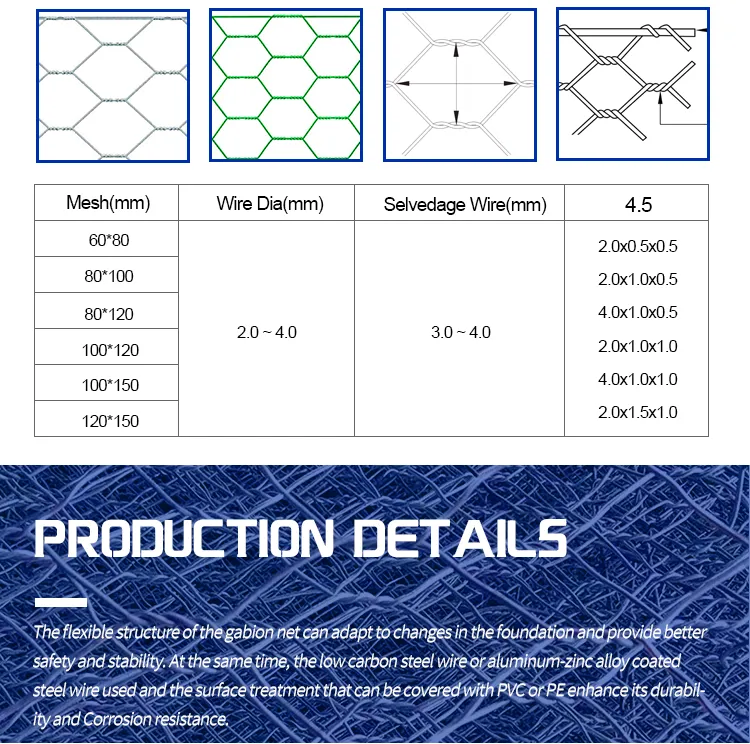-
 Phone:
Phone: -
 Email:
Email:

Installation of Rockfall Netting for Enhanced Slope Stability and Safety Measures
Rockfall Netting Installation A Comprehensive Overview
Rockfall netting is an essential safety measure employed in various terrains prone to landslides and rockfalls. Such installations are crucial in protecting infrastructure, vehicles, and lives from the unpredictable nature of falling rocks. This article will delve into the importance of rockfall netting installation, the types of netting available, the installation process, and the benefits it offers.
The Importance of Rockfall Netting
Rockfalls can occur in mountainous regions, roadways, and urban areas where steep cliffs or unstable slopes are present. The consequences of a rockfall can be devastating, causing injury or death and resulting in significant property damage and economic loss. Therefore, effective preventative measures are crucial in mitigating these risks. Rockfall netting serves as a barrier that intercepts falling debris, containing it and directing it away from critical areas.
Types of Rockfall Netting
Various types of rockfall netting systems are available, each designed for specific conditions and applications. The most common include
1. High-Tension Wire Netting This type uses robust wires that are tensioned tightly to resist the impact of falling rocks. It's ideal for areas with larger and heavier boulders. 2. Low-Tension Wire Netting Often used in sites with smaller debris, low-tension netting is less robust but still effective in preventing small rocks from falling onto roads or populated areas.
3. Mesh Netting Composed of fine wire mesh, this is suitable for controlling smaller fragments and is often used in combination with other systems for added security.
4. Rockfall Barriers While not netting in the traditional sense, these barriers work in tandem with netting systems to provide an additional layer of protection against larger rockfalls.
The Installation Process
The installation of rockfall netting involves several critical steps to ensure effectiveness and longevity.
rockfall netting installation

1. Site Assessment Before installation begins, a thorough geological survey is conducted to identify potential rockfall sources and assess the terrain. This assessment helps determine the type of netting required and the most effective installation method.
2. Design Planning Based on the site assessment, engineers design a tailored rockfall netting system. This plan outlines the layout, required materials, and anchoring methods.
3. Preparation of the Site Clearing the area of any loose debris and vegetation is at the forefront. This step ensures that the installation can occur without obstruction and reduces the risk of immediate rockfalls during the process.
4. Installation of Anchors Heavy-duty anchors are installed into the ground or rock face to support the netting. These anchors must be strategically placed to withstand the forces exerted by falling rocks.
5. Netting Installation The netting is carefully deployed over the designated area and secured to the anchors. Proper tension must be maintained to effectively contain any potential rockfall.
6. Final Inspection and Maintenance After installation, a comprehensive inspection is conducted to ensure everything is secured properly. Regular maintenance checks are also essential to monitor the system's condition and address any wear or damage promptly.
Benefits of Rockfall Netting
The installation of rockfall netting presents several benefits, including
- Enhanced Safety By preventing loose rocks from falling onto roadways, housing, or public spaces, netting systems significantly reduce the risk of injury or fatal accidents. - Cost-Effective Solution While installation may require initial investment, the long-term savings in preventing damage to infrastructure and the costs associated with accidents are substantial.
- Environmental Preservation Rockfall netting helps maintain the natural landscape by stabilizing rocky slopes, preventing excessive erosion, and supporting local wildlife habitats.
In conclusion, rockfall netting installation is a vital component of landscape management in areas susceptible to rockfalls. With proper assessment, design, and installation, these systems not only protect lives and properties but also contribute to the preservation of the surrounding environment. Investing in rockfall netting is an investment in safety and sustainability for communities in vulnerable regions.
-
Wire Mesh for Every Need: A Practical SolutionNewsJul.25,2025
-
Steel Fences: Durable, Secure, and Stylish OptionsNewsJul.25,2025
-
Roll Top Fencing: A Smart Solution for Safety and SecurityNewsJul.25,2025
-
Cattle Farm Fencing Solutions for Maximum SecurityNewsJul.25,2025
-
Affordable Iron Binding Wire SolutionsNewsJul.25,2025
-
Affordable Galvanized Wire SolutionsNewsJul.25,2025
-
Wire Hanger Recycling IdeasNewsJul.25,2025








